 Facebook
Facebook
 X
X
 Instagram
Instagram
 TikTok
TikTok
 Youtube
Youtube
Chances are, 9 out of 10 people who read this sentence do so despite a feeling of guilt. The tenth person lives at home with his parents.
The sense of guilt is induced by that cultural universal, "the apartment." Apartments are hard masters, driving people to fantasies of impotence and deliriums of expenditure. They make it uncomfortable to be perusing the Reader, because of the feeling deep down inside that really, "1 ought to be refinishing those dining-room chairs," which were bought at a discovered "junque shop" painted bright green, but which down underneath "really seem very much like walnut." Impotence is the product of plumbing: "If Steve McQueen knows so much about racing cars, why does my toilet make that terrible dribbling sound all night long, and why can't I do anything about it?"
But there is no good reason for the apartment to stay master of the man. Most devices which cause annoyance are remarkably simple, and there is no reason to suffer patiently while waiting for the landlord to fix a faucet or to pay exorbitant fees to a card-carrying professional. This week we will cover two devices found in every apartment, without exception: faucets and locks. If you would prefer never again being Chinese- tortured by a dripping spigot, or agitated by the knowledge that a particular lock wouldn't keep anybody out, read on.
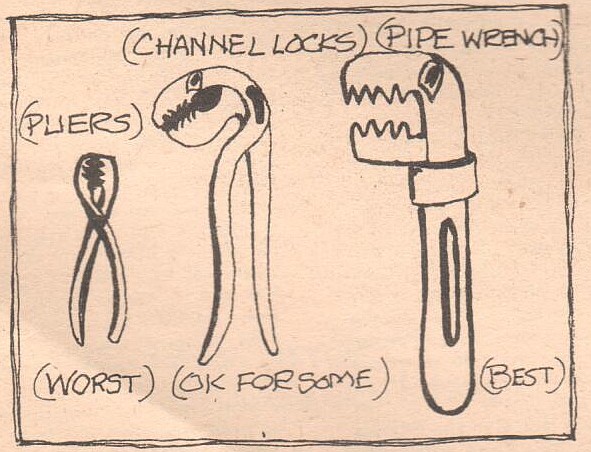
You must first determine whether the hot or cold water is leaking. Almost invariably, it will turn out to be the hot. Tum off the main water supply to the building (generally the valve is in the front of the basement) and then open the faucets and wait for the water to stop coming out. If it doesn't, you've turned off the wrong valve. Go back and try another. In buildings with relatively modern plumbing, there is generally a valve on the feed pipe which makes a more satisfactory alternate means of shutting off the water supply to only one faucet. But at any rate, if you start to uncouple faucets without turning off the water, you had better know how to swim.
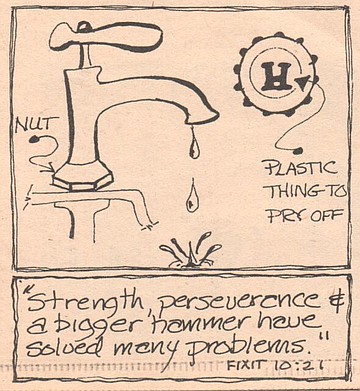
Once water is off, take a large pair of pliers and apply it to the top nut of the faucet.
On some faucets, it will be necessary to pry off the cap of the handle and unscrew it before the nut will be exposed.
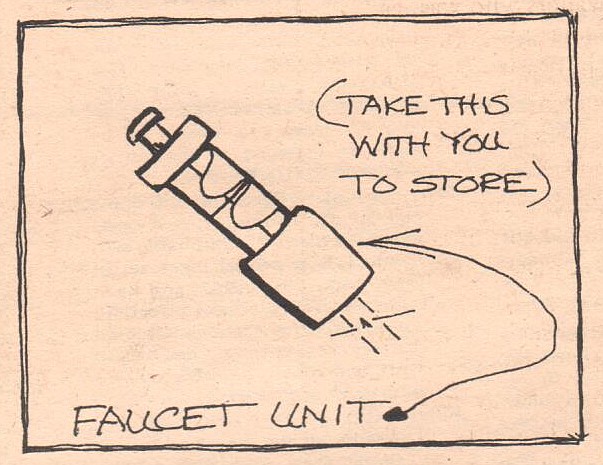
Water often corrodes the plastic in faucet-handles, so it may take some strength to get apart. After pulling out the faucet unit, you are ready to determine what sort of washer is needed to fix the leak. Generally, the easiest thing to do is to take the entire unit down to your neighborhood hardware store, where the salesman can determine what size and type of washer is needed.
There are two types and a few sizes of washers. Older faucets tend to use beveled washers, while more modem ones use flat. An occasional faucet having totally different washers may be encountered, but the hardware store should recognize these.
At the bottom of the unit, there is a brass screw. Unscrew it, and lift or pry out the old washer. The old washer may be so wasted
away that only the screw may remain. Now, put in the new washer, tighten the brass screw. and reverse the process by which you took the faucet apart. Replace the unit in the faucet. and tighten the nut on top. Now replace the handle if there was one. You are now ready to turn the water on, so do so, while praying. If you're lucky, nothing will happen, and when you turn the handle on the faucet, water will run. If you're not lucky, water will just continue to run out, no matter what the position of the handle, and you had better take the unit back to the hardware store for further consultation.
In most buildings there is some kind of access to the main water valve. If you don't know about it, ask the janitor for assistance, and he might even lend you the tools you need.
A small package of washers should sell for 39 to 49 cents, thus making the job much cheaper than the $10· 15 which a plumber would charge.
Changing lock cylinders is remark ably simple, and it often pays to do it yourself. For one thing. it will demonstrate to the apartment dweller how simple your lock is to tamper with. thus destroying any false feelings of confidence. A lock is only as good as the door it is mounted on.
The cylinder is the active mechanism of a lock which causes it to lock or unlock. Generally bolts are entirely separate, so that various kinds of cylinders will work with a single bolt installation. For that reason, changing cylinders may actually be the easiest way to change the keying of a lock. A locksmith could be called to "re-key" an existing cylinder, but he would often charge more than the cost of a moderately priced new cylinder. Let us look at the two most common types of apartment locks, the rim cylinder and the mortise cylinder, and see how they can be changed.
Rim cylinders are generally found on locks which lock behind the door; that is, those which do not use a bolt located in the door itself. The first step is to remove that inside portion, which is generally accomplished by removing four screws. This should expose the back plate.
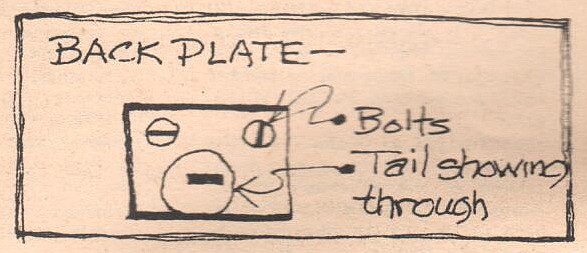
The flat piece of metal sticking through the hole is the activating part (called the tail): if the right key is turned in the lock, it will tum as well, thus locking or unlocking the bolt. To remove the cylinder, you must unscrew the bolts and lift it out from the front. It will be wise to take the old cylinder with you to the hardware store to be sure of getting a new cylinder of approximately duplicate design. Look particularly at the tail-some cylinders have vertical and other cylinders horizontal tails. And they are not always interchangeable.
Once the new cylinder has been selected, it is a relatively easy matter to push it in from the front and secure it with the bolts that come with it. You must be sure that the new bolts are the same length as the old ones, however, or they may not fit. Once the bolts are in place, the lock can be replaced on the back with care taken to be Sure that the back is aligned correctly. These are the pieces you are dealing with, in case you get confused.
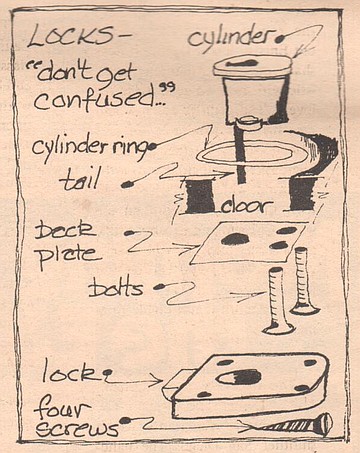
Rim cylinders range in price from $1.69 for a diecasr potmetal import from Japan or made by ILCO, through solid brass models made by ILCO, Lockwood, Segal, and others, that cost between $5 and $10 — and which are probably your best buy-and ending at the top of the line with pick-proof cylinders made by Medeco or Sgt. Keso, or others, which cost anywhere from $25 to thousands of dollars.
Mortise cylinders are locks inside a door controlling a deadbolt. These are locks which show a round cylinder in the front of the door, generally above the handle, but nothing in back. Since they do not go all the way through the door, they must rest on set screws put in through the edge of the door to keep them in place. Generally, there is a holding screw and one or two set screws, which must be removed to get the cylinder out. This type of cylinder then must be unscrewed itself, since it is actually screwed into threads inside the door. Once it has been removed, take it with you to the hardware store to be sure you are getting a cylinder with approximately similar tail.
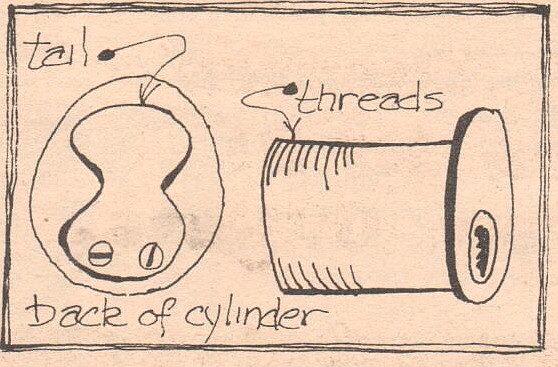
Installing the mortise cylinder can be more difficult since it must align properly after having been screwed into its threads. It may be necessary to try varying numbers of turns and varying numbers of cylinder rings. Once it is in place, it is held by the set and holding screws.
A new mortise cylinder begins at about $3.50. The best buys are in the $4 to $7 range, and are made of solid brass or bronze. Just as there are high-priced rim cylinders, there are high-priced unpickable mortise cylinders as well.

If you have difficulties. most hardware stores will provide free advice. No problems should be encountered if you proceed carefully, however, noting exactly how the lock or faucet was originally as you took it apart.

Chances are, 9 out of 10 people who read this sentence do so despite a feeling of guilt. The tenth person lives at home with his parents.
The sense of guilt is induced by that cultural universal, "the apartment." Apartments are hard masters, driving people to fantasies of impotence and deliriums of expenditure. They make it uncomfortable to be perusing the Reader, because of the feeling deep down inside that really, "1 ought to be refinishing those dining-room chairs," which were bought at a discovered "junque shop" painted bright green, but which down underneath "really seem very much like walnut." Impotence is the product of plumbing: "If Steve McQueen knows so much about racing cars, why does my toilet make that terrible dribbling sound all night long, and why can't I do anything about it?"
But there is no good reason for the apartment to stay master of the man. Most devices which cause annoyance are remarkably simple, and there is no reason to suffer patiently while waiting for the landlord to fix a faucet or to pay exorbitant fees to a card-carrying professional. This week we will cover two devices found in every apartment, without exception: faucets and locks. If you would prefer never again being Chinese- tortured by a dripping spigot, or agitated by the knowledge that a particular lock wouldn't keep anybody out, read on.

You must first determine whether the hot or cold water is leaking. Almost invariably, it will turn out to be the hot. Tum off the main water supply to the building (generally the valve is in the front of the basement) and then open the faucets and wait for the water to stop coming out. If it doesn't, you've turned off the wrong valve. Go back and try another. In buildings with relatively modern plumbing, there is generally a valve on the feed pipe which makes a more satisfactory alternate means of shutting off the water supply to only one faucet. But at any rate, if you start to uncouple faucets without turning off the water, you had better know how to swim.

Once water is off, take a large pair of pliers and apply it to the top nut of the faucet.
On some faucets, it will be necessary to pry off the cap of the handle and unscrew it before the nut will be exposed.

Water often corrodes the plastic in faucet-handles, so it may take some strength to get apart. After pulling out the faucet unit, you are ready to determine what sort of washer is needed to fix the leak. Generally, the easiest thing to do is to take the entire unit down to your neighborhood hardware store, where the salesman can determine what size and type of washer is needed.
There are two types and a few sizes of washers. Older faucets tend to use beveled washers, while more modem ones use flat. An occasional faucet having totally different washers may be encountered, but the hardware store should recognize these.
At the bottom of the unit, there is a brass screw. Unscrew it, and lift or pry out the old washer. The old washer may be so wasted
away that only the screw may remain. Now, put in the new washer, tighten the brass screw. and reverse the process by which you took the faucet apart. Replace the unit in the faucet. and tighten the nut on top. Now replace the handle if there was one. You are now ready to turn the water on, so do so, while praying. If you're lucky, nothing will happen, and when you turn the handle on the faucet, water will run. If you're not lucky, water will just continue to run out, no matter what the position of the handle, and you had better take the unit back to the hardware store for further consultation.
In most buildings there is some kind of access to the main water valve. If you don't know about it, ask the janitor for assistance, and he might even lend you the tools you need.
A small package of washers should sell for 39 to 49 cents, thus making the job much cheaper than the $10· 15 which a plumber would charge.
Changing lock cylinders is remark ably simple, and it often pays to do it yourself. For one thing. it will demonstrate to the apartment dweller how simple your lock is to tamper with. thus destroying any false feelings of confidence. A lock is only as good as the door it is mounted on.
The cylinder is the active mechanism of a lock which causes it to lock or unlock. Generally bolts are entirely separate, so that various kinds of cylinders will work with a single bolt installation. For that reason, changing cylinders may actually be the easiest way to change the keying of a lock. A locksmith could be called to "re-key" an existing cylinder, but he would often charge more than the cost of a moderately priced new cylinder. Let us look at the two most common types of apartment locks, the rim cylinder and the mortise cylinder, and see how they can be changed.
Rim cylinders are generally found on locks which lock behind the door; that is, those which do not use a bolt located in the door itself. The first step is to remove that inside portion, which is generally accomplished by removing four screws. This should expose the back plate.

The flat piece of metal sticking through the hole is the activating part (called the tail): if the right key is turned in the lock, it will tum as well, thus locking or unlocking the bolt. To remove the cylinder, you must unscrew the bolts and lift it out from the front. It will be wise to take the old cylinder with you to the hardware store to be sure of getting a new cylinder of approximately duplicate design. Look particularly at the tail-some cylinders have vertical and other cylinders horizontal tails. And they are not always interchangeable.
Once the new cylinder has been selected, it is a relatively easy matter to push it in from the front and secure it with the bolts that come with it. You must be sure that the new bolts are the same length as the old ones, however, or they may not fit. Once the bolts are in place, the lock can be replaced on the back with care taken to be Sure that the back is aligned correctly. These are the pieces you are dealing with, in case you get confused.

Rim cylinders range in price from $1.69 for a diecasr potmetal import from Japan or made by ILCO, through solid brass models made by ILCO, Lockwood, Segal, and others, that cost between $5 and $10 — and which are probably your best buy-and ending at the top of the line with pick-proof cylinders made by Medeco or Sgt. Keso, or others, which cost anywhere from $25 to thousands of dollars.
Mortise cylinders are locks inside a door controlling a deadbolt. These are locks which show a round cylinder in the front of the door, generally above the handle, but nothing in back. Since they do not go all the way through the door, they must rest on set screws put in through the edge of the door to keep them in place. Generally, there is a holding screw and one or two set screws, which must be removed to get the cylinder out. This type of cylinder then must be unscrewed itself, since it is actually screwed into threads inside the door. Once it has been removed, take it with you to the hardware store to be sure you are getting a cylinder with approximately similar tail.

Installing the mortise cylinder can be more difficult since it must align properly after having been screwed into its threads. It may be necessary to try varying numbers of turns and varying numbers of cylinder rings. Once it is in place, it is held by the set and holding screws.
A new mortise cylinder begins at about $3.50. The best buys are in the $4 to $7 range, and are made of solid brass or bronze. Just as there are high-priced rim cylinders, there are high-priced unpickable mortise cylinders as well.

If you have difficulties. most hardware stores will provide free advice. No problems should be encountered if you proceed carefully, however, noting exactly how the lock or faucet was originally as you took it apart.
Comments